
Dr. Allen (Al) L. Larson, PhD
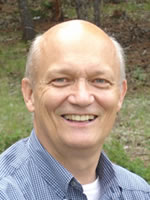
Education
1956-1960 Lead High School, Lead, South Dakota1960-1964 BS -Engineering Science, USAF Academy
1970-1972 MS and PhD -Electrical & Computer Engineering, University of Wisconsin-Madison
Before the Academy
I grew up near Lead, in the Black Hills of South Dakota. Lead was the home of the historic Homestake Gold Mine, which funded Randolf Hearst's "yellow journalism." We lived outside Lead on a tiny farm. So I grew up doing farm chores. I did well in school, but chores and a paper route kept me out of sports after school. I discovered ham radio, and that began my love affair with electronics. In high school, I read the book, "Machines Who Think." That began my love affair with computers. In grade school, I read "The Lafayette Escadrille," about the American volunteer flyers in WWI. That, the bombers from nearby Ellsworth Air Force base flying overhead, the newspaper accounts of the Saber/MIG battles in Korea, and building model airplanes stimulated my interest in flying.SPUTNIK! read the headlines, as I picked up my pile of papers to deliver on October 4th, 1957. That changed a lot. I went home and listened to the Sputnik signal on my ham receiver. It sent chills down my spine. The space race was on, and we were losing! In high school, five of us asked for and got an accelerated math class.
So when a teacher asked if I was interested in applying to the USAF Academy, I said yes. I had a ham buddy, Ken Habendank, who had just joined the Class of 1963. He told me it was a great way to get an education AND fly. Somehow I got into the Class of 1964.
My Cadet Days
I thoroughly enjoyed my cadet days. I bought into the "whole man" concept, and the idea of pulling together as a team. I spent all four years in Fighting Fourth Squadron. As a doolie, that got you hazed a lot. An upper classman would ask, "What are you fighting for, smack?" My answer, "I'm fighting the Dean, sir!" usually got me off the hook, to the peals of laughter.I made the Dean's list every semester. But I was really struck by the competition. There were a lot of smart people in this class. One sticks out in my mind - Bob Lodge. I still think he was the smartest man I ever met. I always figured he would wind up as Secretary of State or President. When I learned that he had been lost in Vietnam, I knew what a great price freedom was asking of us.
I remember the bone chilling trip to march in President Kennedy's parade. And burned into my memory is the day that General Ryan was having lunch at my table, because his son Mike (later Chief of Staff) was at my table. General Ryan got called to the staff tower. He returned a few minutes later, obviously shaken, and told us President Kennedy had been shot in Dallas.
I only made the Sup's list once. I did work hard to stay off confinements and tours. In my senior year, our AOC, Marine Capt. Freddie Mathews, decided to put all firsties on confinements. I was escaping his dragnet, until one day when I was head of Security Flight. It was a blustery day, and the flag kept tangling. I kept sending people out to straight it out. Capt. Mathews still wrote me up for it, a punishment which would get me three confinements. But I knew King Hussein of Jordan was coming the next day, and in honor of his visit, all confinements and tours on the books that day would be removed. I made sure my Form 10 was in the books that night. A week later Capt. Mathews asked me what happened to my confinements. After I told him that the King's visit had wiped them out, he never bothered me.
I really liked cadet life. The spirit of cooperate and graduate was great. I tutored, and was tutored, by many of my squadron mates. It was us against the dean. The honor code put strict boundaries on what help we could give each other, but it was fair game to make up our own tests in a course, and figure out how we would answer them. By the time we were firties, several of us were pretty good at it. Just before graduation, a team of us made sure a certain classmate quit arguing with the professors and just gave them the answers they wanted.
Too late to lose anyone then! That certain classmate went on to made general. I also really enjoyed intramural sports. I played soccer, rugby, football, basketball, and wrestled. Since I had not had the opportunity to play high school sports, I didn't think of myself as an athlete. But I found I was pretty good, if not varsity quality. One day I pinned a varsity soccer player in a wrestling match. Great for my self esteem.
I saw my first digital flip-flop in the analog computer lab at the Academy. I wrote my first Fortran computer programs as a third classman (1961). We had to key punch our programs onto punched cards. They were mailed to UCLA, where they got run on an IBM 7090. Three weeks later we'd get a printout, saying "Syntax Error" due to a typing error. Fortunately, after one round of this, the instructor authorized us to check each other's typing, but not program logic. Thank God for Ed Harvey's sharp eyes. OK, so Ed was nearly blind, but he saw my errors, and he got a waiver to fly anyway.
I was in the Ski Club and the Radio Club.
US Air Force
7 /64-7/65 Pilot Training, Vance AFB, Enid, Oklahoma
Learned to fly in All Jet program in T-37 and T-38
I was in Class 66B at Vance AFB. Tough class to be in , with the likes of Al McArtor, Fred Olmstead, and Terry Isaacson.
I nearly washed out in T-37's. I could not land the airplane. My instructor could not figure out the problem. I was scheduled for a final elimination check ride on Monday. Sunday I went down to the flight line and had a talk with a T-37, like I used to have with a misbehaving cow. Walking home, I realized I was looking down for the runway during the landing, rather than focusing my eyes way down the runway. The resulting speed blur ruined my depth perception. Monday I looked in the right place, greased my landings, and passed with flying colors. God helped me Just In Time. I went on to graduate high enough in my class to get an instructor slot, but not a fighter.
8 /65-11/68 Advanced Jet Instructor Pilot, Craig AFB, Alabama
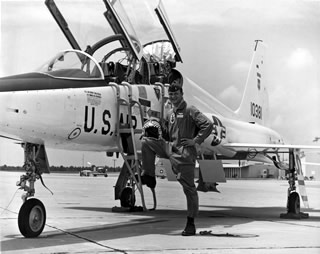 Taught flying in T-38 supersonic trainer. Graduated every student
assigned when normal washout rate was 33%. Named Instructor of the Month.
Promoted to 1st Lt. and Captain.
Taught flying in T-38 supersonic trainer. Graduated every student
assigned when normal washout rate was 33%. Named Instructor of the Month.
Promoted to 1st Lt. and Captain.
(it really helped that I knew how to teach landings )
It was a real experience for this Yankee boy to live in Selma, Alabama during the civil rights movement. I had no experience with racial bias, but I started getting clues when I walked down the sidewalk in Selma and people of color stepped into the gutter to let me pass. We had a great black pilot, Chuck Guthrie, in our flight. When it came time for his going away party, we arranged to have it in a very upscale restaurant in Montgomery, the Blue Moon.
They didn't know until we walked in that the guest of honor was black. The management blinked, but decided not to press the issue. You cannot imagine the service we got from the black wait staff!
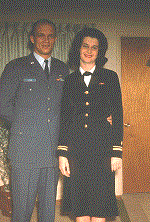
This was a dangerous tour. In my 3 1/2 years at Craig, we lost 13 aircraft. We needed pilots for Vietnam, and we flew hot and heavy. Tired people make mistakes. I got lots of hours.
I also got the nick name, "The McQuire Kid." Since I was a bachelor, I would volunteer to take some married instructor's student cross country. Then I would strong arm the student to go into McQuire AFB near New York, with two flights Friday night, have Saturday off, and return Sunday. The reason? I was getting serious about Nancy Buckley, whom I had met on a blind date third class year. She was a nurse in the Navy, stationed on Long Island. The cross country visits worked. We got married just before I went to Vietnam.
11 /68-11/69 Air Liaison Officer/Forward Air Controller - Vietnam
Directed bomb strikes within 300 feet of friendly troops while flying unarmed light aircraft. Job required quick, sound judgment under fire. Was given Liaison Officer's job even though not of appropriate rank. Flew 421 combat missions. Received Air Medal with 12 oak leaf clusters, Distinguished Flying Cross, and Bronze Star.
[ See my story My Vietnam Days linked at the end of this history for details ]
11 /69-7/73 Master's and PhD - University of Wisconsin-Madison
Sponsored by Air Force for Master's Degree. Extended for PhD at suggestion of school. Completed normal 5 year PhD program in 18 months. Worked in all phases of analog, hybrid, and digital computation. Wrote computer library programs for Engineering Research Center. Major areas: computers and automatic control. Minor: numerical analysis. Thesis: Theory and Design of Precision Digital Integrators. Built working prototype.
My 3 1/2 years in Madison were busy. I couldn't believe the Air Force was paying for me to get a Master's degree. I was originally sent for 2 years, under sponsorship of the Department of Electrical Engineering, USAFA. In my last year, unknown to me, a professor from Wisconsin stopped in to visit Col. Thomas at the Academy. He convinced Col. Thomas that I should get a PhD. This fit in with Col. Thomas' instructor schedule, so he asked AFIT to make it happen. Wisconsin expected you to spend 2 or 3 years getting a Masters, and five to get a PhD. AFIT allowed 2 for a Masters, and 3 for a PhD, but not consecutively. So they just changed my program to a 3 year PhD, and gave me a 6 month extension. So all I had to do was complete the 7 years of work Wisconsin expected in 3 1/2. It took a lot of effort, and several letters requesting waivers for interval rules, but I did it. I knew I would never have this opportunity again.
Going to Wisconsin during the Vietnam war was an experience. The campus was a center of anti-war protests. While I was there, the Weathermen bombed the Math building, killing a researcher. I went to class under the fixed bayonets of the National Guard, with the smell of tear gas in the air. I later found out that Tom Tietenberg and a high school classmate of mine were there at the same time.
Not all my time was spent studying. My daughter Amy and son Mark were born while we were in Wisconsin.
7 /73-11/75 Associate/Assistant Professor, DFEE, USAF Academy
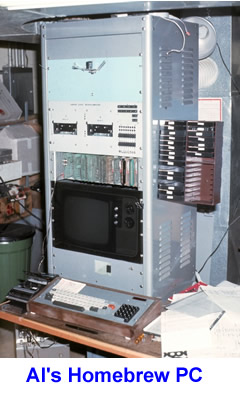 Did study to determine impact of microprocessors.
Correctly predicted microprocessor and educational revolution.
Designed advanced data acquisition system for AF Weapons Lab.
Developed complete microprocessor development system. Gained
outstanding reputation teaching electronics, systems, design
and programming. Promoted to Major.
Did study to determine impact of microprocessors.
Correctly predicted microprocessor and educational revolution.
Designed advanced data acquisition system for AF Weapons Lab.
Developed complete microprocessor development system. Gained
outstanding reputation teaching electronics, systems, design
and programming. Promoted to Major.
During this period, I designed and built my own personal computer at home, before any personal computers were commercially available. I foresaw the coming PC revolution.
11 /75-11/78 Director, Computer Systems Lab, DFEE, USAF Academy
Supervised 10 people implementing new digital curriculum. Responsible for course design, training, budgeting, procurement, and hardware and software development of microcomputers. Redirected laboratory from analog to digital in two years. Developed original material in hardware/software development and microprocessor programming. Research consultant. Designed microprocessor controller for NASA shuttle payload. System architect for Academy solar house control system.
Wrote two texts and designed two laboratory trainers to teach how computers work. Educomp trainer was used by over 11,000 cadets. The Academy valued Educomp so much that they designed a new model when the originals wore out.

Provided material to over 90 universities. Invited speaker at many conferences and workshops. Received Air Force Meritorious Service Award for this work.
While at the Academy, my Air Force career began to fall apart. First, in response to the Gate legislation, AF Personnel attempted to assign me to go fly B-52s. I told a shocked young Captain I didn't get a PhD to fly BUF's. The Academy worked out a deal with AF Personnel, and I added T-41 Instructor to my duties.
Then came the birth of Scott, our third child. Scott was born severely retarded, with an encephalocele on the back of his head. Some unknown part of his brain was in a sac about half the size of his head. He never came home. Additionally, the entire left side of his body was malformed. The Academy hospital could not handle his condition, so he was sent to Fitzsimmons in Denver. There we were told that the encephalocele had to be removed, or Scott would die. But they could not tell how much of his brain was in the sac, so what function he would have was unknown. We did the surgery, Scott survived, and we placed him at Jefferson's Home For Children in Texas, paid for under the Champus program.
Then I "slipped a disk", spent three weeks in traction in the Academy hospital, and got grounded. Bingo, I fell back 9 years on the pay scale. The final straw was the change in the performance rating system. I had always gotten nothing but 10's. Suddenly, under the 1,2,3 system, I was in a population of 2. One of us had to get a 1 and one of us had to get a 3. Whether by department politics or an unlucky coin toss, I got the 3. Even with the Deans' endorsement, I figured this meant Major was all I'd ever make. I decided to get out. That very weekend, for the only time ever, Bell Laboratories, Denver ran an ad looking for engineers. God opened a door just when I needed it most.
AT &T Bell Labs
11 /77-11/79 Member of Technical Staff, Exploratory Systems Group
Invented and implemented test language, compiler, and runtime software and hardware for SST 1 digital circuit test system. System was used to test original Antelope (code name for System 85 prototype) circuit boards, and later System 85 boards. System 85 was AT&T's flagship Private Branch Exchange (PBX) product. Responsible for integration of original Antelope testbed. Designed shared memory and software tracing hardware for that system. Evaluated microprocessors. Tested first 8086 chips from Intel. Invented dual processor bus structure used in AT&T System 75, Audix, and Kudu exploratory project.
Wrote a Technical Memorandum on memory management for microprocessors. This memo influenced Intel's design of the 386 microprocessor. Consulted with Intel on 8086, 286, and 386 microprocessor designs. Personally identified problem in 386 design that would have prevented that chip from running modern operating systems, like Unix and Windows. Intel implemented my suggested solution.
During this period, at home, I purchased the first IBM PC sold in Denver. IBM's entry galvanized the PC market.
11 /79-3/81 MTS, Advanced Technology Group
Procured space, people, equipment, parts, etc. to establish new advanced systems department. Developed SST 3 tester software and hardware. SST 3 used by many development groups for test and debugging of digital systems.
Designed first digital voice storage port boards. Work led to AT&T product known as the AT&T Audix Voice Mail System. Designed and built high performance Ethernet message handler system as part of one of first three working Ethernets in the world. Ethernet later became and still is the way personal computers are connected.
Received two patents on this work.
3 /81-1/83 Supervisor, Advanced Technology Group
Assembled and supervised team that built advanced office automation demonstration system. System illustrated a user friendly integrated voice, data, and video (IVDV) system. This networked personal workstation system pioneered local area networks, bit-mapped displays, windows based user interface, mouse control, object oriented software, and integrated voice, data, and video switching. This system was a precursor of today's networked personal computers, and foresaw the carrying of voice and video over the digital data network.
1 /83-4/84 Supervisor, Advanced Switching Group
Supervised construction of next generation PBX prototype. Investigated market and technology issues of video/wideband switching. Began digital video switch design work. Group developed circuit board CAD tools. First proposed and supervised proposal phase of Personal Computer Enhanced Telephone work. Became AT&T product called PC/PBX Connection.
4 /84-4/88 Supervisor, Video Switching Development Group
Directed team of 14 engineers and programmers who developed a fiber based Video Information System, code named Cheetah. The system consisted of a fiber based digital video switch, which connected remotely controlled media servers with classroom/office terminals. This system was a pre-cursor to the Internet. It was first used in the University of Pittsburgh's Campus of the Future.
As part of this project, developed Cheetah/Pecos realtime operating system, which became the recommended AT&T Operating System for embedded systems, as UNIX was for multi-user systems. Group received patent on system.
5 /88-4/91 Supervisor, Advanced Technology Group
Conducted work in broadband switching, high speed circuit design, fiber LAN's, Broadband ISDN, and multimedia communications. Group invented and built a new type of broadband switching fabric. Received three patents on this work. Co-invented and managed development of prototype photonic switch. Received patent on this work.
My years at Bell Labs were great. It was like doing post doc work with the brightest minds in the world. I learned an enormous amount about communications, computers, and software. I could pick up the phone and talk to someone like Dennis Ritchie, one of the inventors of the C Language and Unix, and ask him how to make a modification to his C compiler. I was part of the microcomputer revolution, seeing the company replace custom processors with microprocessors. I learned all about real time operating systems from Gary Sager, who had written one for the Cray super computer at Los Alamos before coming to Bell Labs. There was no limit to what one could learn. My leadership skills learned in the Air Force let me build good, highly productive groups, and focus them on interesting, important projects.
But the larger AT&T company was in a tailspin. Forced to give up it's century long monopoly on the US telephone system the monopoly "we have infinite time" culture failed to make the switch to the highly competitive "yesterday is old, we want new" culture of high technology. We went from getting 15% per year pay raises, and hefty budgets, to 1% raises, and constant 15 percent staff cuts. I saw the handwriting on the wall. I took the first buyout offer for which I was eligible. I decide to go home and start my own company.
MicroMedia
4 /91-present- President of MicroMedia
Built my own small business in stock and commodity trading and education. Created state of the art multi-processor web based business system. Built and operated http://moneytide.com and http://daytradingforecasts.com websites. Created new Chaos Model of Markets. Developed unique forecasting methods. Provided market forecasts via hotlines, faxout service, newsletter, and email. Conducted weekly live Chaos Clinic webinars. Created variety of educational materials including innovative Cash In On Chaos, Fractal of Pi, Face of God, Chaos Trading Made Easy, and Market AstroPhysics courses. Developed several advanced computer programs for traders. Correctly forecast Crash of 1987, 1989 top of Japanese Market, 2000 top of US market, and Crash of 2008. Wrote free ebook, Your Electric Life, downloaded by over 12,000 people. This business was made possible by my home use of PC's. The investment I made in my own home computers and my own education set me free.
In an unexpected honor, in 2010, I was elected to my high school's Hall of Fame. Some of my classmates found my business website and an early version of my bio, and made a big deal out of it. I was honored to be only one of 16 graduates honored at a school with a 116 year history. My Air Force service was a big reason for this honor. It did make our 50th reunion fun.
Personal
I've been married since 1968 to the love of my life, Nancy (Buckley) of Denver. Nancy is a pediatric nurse, served in the US Navy, got a Master's degree, and had a very successful 23 year career at Kaiser Permanente.Our son Scott died of a seizure at age 21. A week later, Nancy's brother, Patrick, died of a heart attack. He was married to Wava, who was my clerk at MicroMedia. This was a tough time.
Amy went on to get a PhD in Electrical Engineering, and works at Los Alamos Laboratories. Mark got a BS in Electrical Engineering, became an Internet programmer, and started his own company. He sold that when he was hired into another startup. He recently cashed on that startup in a business deal that now has him working for as a contract programmer. He and wife Coleen have three children, whom we spoil regularly, since they live 10 minutes away.
Nancy and I have raised three children, took care of aging parents, became grandparents, and met numerous life challenges. God has blessed us, especially with each other, our children, and our grandchildren. And of course, our two cocker spaniels.
The main lesson I've learned in life, which I got from my combat tour, is not to sweat the small stuff. I've become known for saying, "If they ain't shooting real bullets, don't sweat it."
I feel blessed to have been a member of the Class of 1964. One could not be associated with a finer group of men. I truly believe this class is the Greatest Class. No One's Done more that '64.
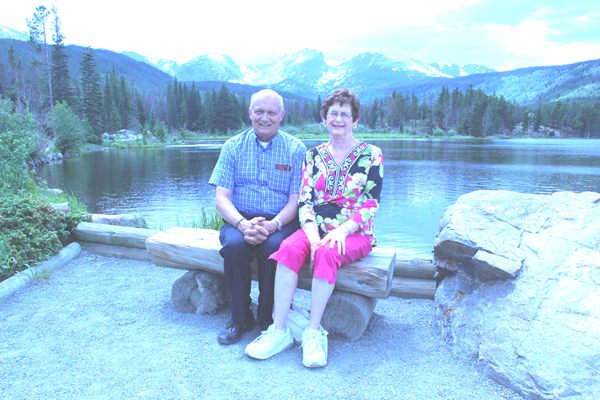
Nancy and Al in Rocky Mountain National Park, 46th Anniversary, 2014
[ The Steel Hand Of Death and Other Poems ]
[ My Vietnam Days ]
[ Bring Me Men ]
[ Educomp Makes The News ]
[ History Of Our Times ]
[ Living One Day At A Time ]
[ Class 66B Vance AFB ]
[ Your Electric Life ]
[ Address to 33rd Squadron Commissioning Ceremony, Class of 2014 ]
[ Home ] [ Table Of Contents ]